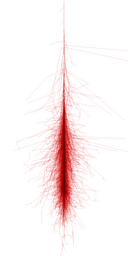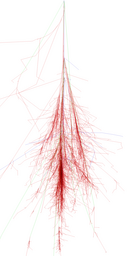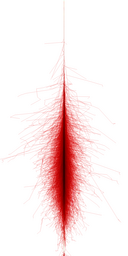 |
 |
 |
 |
|
| Photon shower | Proton shower | Iron shower | Muon shower | |
| (Compiled by Fabian Schmidt, University of Leeds, UK) | ||||
CORSIKA (COsmic Ray SImulations for KAscade) is a program for detailed simulation of extensive air showers initiated by high energy cosmic ray particles. Protons, light nuclei up to iron, photons, and many other particles may be treated as primaries.
The particles are tracked through the atmosphere until they undergo reactions with the air nuclei or - in the case of instable secondaries - decay. The hadronic interactions at high energies may be described by several reaction models alternatively:The VENUS, QGSJET, and DPMJET models are based on the Gribov-Regge theory, while SIBYLL is a minijet model. The neXus model extends far above a simple combination of QGSJET and VENUS routines. The most recent EPOS model is based on the neXus framework but with important improvements concerning hard interactions and nuclear and high-density effect. HDPM is inspired by findings of the Dual Parton Model and tries to reproduce relevant kinematical distributions being measured at colliders.
Hadronic interactions at lower energies are described either by the GHEISHA interaction routines, by a link to FLUKA, or by the microscopic UrQMD model. In particle decays all decay branches down to the 1 % level are taken into account. For electromagnetic interactions a tailor made version of the shower program EGS4 or the analytical NKG formulas may be used. Options for the generation of Cherenkov radiation and neutrinos exist. The radio emission of showers may be treated by a link with the CoREAS (Corsika-based Radio Emission from Air Showers) code.
CORSIKA may be used up to and beyond the highest energies of 100 EeV.
The latest version is CORSIKA 7.7550 (April 30, 2024).
More information:
Documentation
Downloads
Visualization
